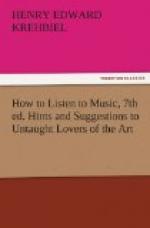[Sidenote: History of the term.]
[Sidenote: Changes in meaning.]
[Sidenote: Handel’s “Pastoral Symphony."]
The word symphony has itself a singularly variegated history. Like many another term in music it was borrowed by the modern world from the ancient Greek. To those who coined it, however, it had a much narrower meaning than to us who use it, with only a conventional change in transliteration, now. By [Greek: symphonia] the Greeks simply expressed the concept of agreement, or consonance. Applied to music it meant first such intervals as unisons; then the notion was extended to include consonant harmonies, such as the fifth, fourth, and octave. The study of the ancient theoreticians led the musicians of the Middle Ages to apply the word to harmony in general. Then in some inexplicable fashion it came to stand as a generic term for instrumental compositions such as toccatas, sonatas, etc. Its name was given to one of the precursors of the pianoforte, and in Germany in the sixteenth century the word Symphoney came to mean a town band. In the last century and the beginning of this the term was used to designate an instrumental introduction to a composition for voices, such as a song or chorus, as also an instrumental piece introduced in a choral work. The form, that is the extent and structure of the composition, had nothing to do with the designation, as we see from the Italian shepherds’ tune which Handel set for strings in “The Messiah;” he called it simply pifa, but his publishers called it a “Pastoral symphony,” and as such we still know it. It was about the middle of the eighteenth century that the present signification became crystallized in the word, and since the symphonies of Haydn, in which the form first reached perfection, are still to be heard in our concert-rooms, it may be said that all the masterpieces of symphonic literature are current.
[Sidenote: The allied forms.]
[Sidenote: Sonata form.]
[Sidenote: Symphony, sonata, and concerto.]
I have already hinted at the fact that there is an intimate relationship between the compositions usually heard at a classical concert. Symphonies, symphonic poems, concertos for solo instruments and orchestra, as well as the various forms of chamber music, such as trios, quartets, and quintets for strings, or pianoforte and strings, are but different expressions of the idea which is best summed up in the word sonata. What musicians call the “sonata form” lies at the bottom of them all—even those which seem to consist of a single piece, like the symphonic poem and overture. Provided it follow, not of necessity slavishly, but in its general structure, a certain scheme which was slowly developed by the geniuses who became the law-givers of the art, a composite or cyclical composition (that is, one composed of a number of parts, or movements) is, as the case may




